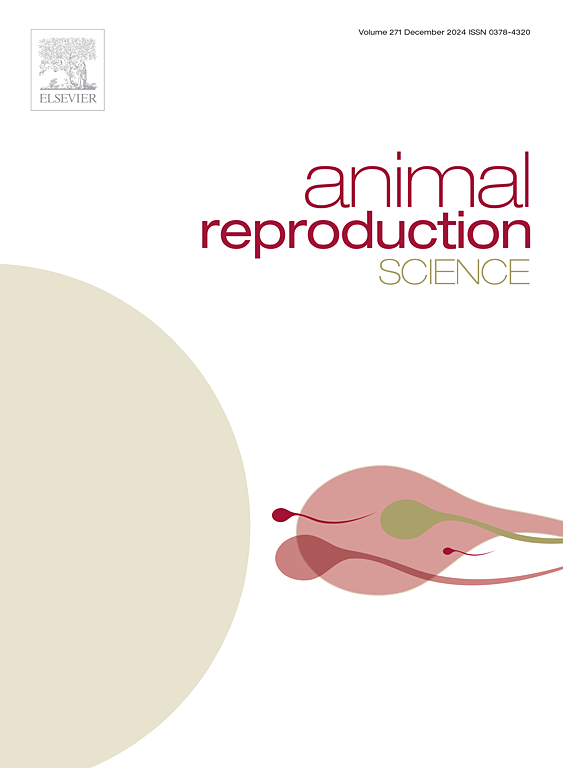Molecules regulating sperm adhesion to and release from the oviduct across species: A systematic review
IF 3.3
2区 农林科学
Q1 AGRICULTURE, DAIRY & ANIMAL SCIENCE
引用次数: 0
Abstract
Despite advances in assisted reproductive technologies (ARTs) such as in vitro fertilization (IVF), fertilization failure remains a major bottleneck in both clinical and animal reproduction, often due to suboptimal sperm selection and premature capacitation processes. One critical but underutilized biological system in sperm selection is the functional sperm reservoir formed in the oviduct after insemination. In this context, spermatozoa bind to epithelial cells in the isthmic region of the oviduct to maintain viability while acquiring fertilization competence until ovulation signals trigger their release from the functional reservoir. While the role of steroid hormones in the sperm-oviductal epithelial cell interaction has been well elaborated, evidence gathered over the years shows that biomolecular factors play a complementary but equally important role in sperm binding to and release from oviductal cells. This review systematically synthesizes evidence from studies investigating interactive biomolecules influencing sperm binding to and release from oviductal epithelial cells (OEC) using in vitro models. Overall, studies reviewed indicate that sperm binding to and release from the OEC, as well as the fertilizing competency of the released spermatozoa, are influenced by specific carbohydrates, glycoproteins, glycosaminoglycans, seminal plasma proteins, and endocannabinoids. Tyrosine phosphorylation states of sperm and the effects of cryopreservation and sex-sorting, also play a role in sperm fertilization competence. Since the interaction between sperm and OEC is crucial for successful fertilization in vivo, these biomolecules, and sperm physiological states also represent a promising target for improving IVF outcomes using cryopreserved or fresh and sex-sorted or non-sorted semen in mammalian species.
调节精子粘附和释放的分子跨物种:系统综述
尽管体外受精(IVF)等辅助生殖技术(ARTs)取得了进步,但受精失败仍然是临床和动物生殖的主要瓶颈,通常是由于精子选择不理想和过早的获能过程。精子选择中一个关键但未充分利用的生物系统是人工授精后在输卵管中形成的功能性精子库。在这种情况下,精子与输卵管峡部的上皮细胞结合以保持活力,同时获得受精能力,直到排卵信号触发它们从功能储存库释放。虽然类固醇激素在精子与输卵管上皮细胞相互作用中的作用已经得到了很好的阐述,但多年来收集的证据表明,生物分子因素在精子与输卵管细胞的结合和释放中起着互补但同样重要的作用。本文系统地综合了利用体外模型研究影响精子与输卵管上皮细胞(OEC)结合和释放的相互作用生物分子的证据。总的来说,研究表明精子与OEC的结合和释放,以及释放的精子的受精能力,受到特定碳水化合物、糖蛋白、糖胺聚糖、精浆蛋白和内源性大麻素的影响。精子的酪氨酸磷酸化状态以及低温保存和性别分类的影响,也对精子的受精能力起作用。由于精子和OEC之间的相互作用对于体内成功受精至关重要,因此这些生物分子和精子生理状态也代表了使用哺乳动物物种的冷冻保存或新鲜、性别分类或未分类精液来改善体外受精结果的有希望的目标。
本文章由计算机程序翻译,如有差异,请以英文原文为准。
求助全文
约1分钟内获得全文
求助全文
来源期刊

Animal Reproduction Science
农林科学-奶制品与动物科学
CiteScore
4.50
自引率
9.10%
发文量
136
审稿时长
54 days
期刊介绍:
Animal Reproduction Science publishes results from studies relating to reproduction and fertility in animals. This includes both fundamental research and applied studies, including management practices that increase our understanding of the biology and manipulation of reproduction. Manuscripts should go into depth in the mechanisms involved in the research reported, rather than a give a mere description of findings. The focus is on animals that are useful to humans including food- and fibre-producing; companion/recreational; captive; and endangered species including zoo animals, but excluding laboratory animals unless the results of the study provide new information that impacts the basic understanding of the biology or manipulation of reproduction.
The journal''s scope includes the study of reproductive physiology and endocrinology, reproductive cycles, natural and artificial control of reproduction, preservation and use of gametes and embryos, pregnancy and parturition, infertility and sterility, diagnostic and therapeutic techniques.
The Editorial Board of Animal Reproduction Science has decided not to publish papers in which there is an exclusive examination of the in vitro development of oocytes and embryos; however, there will be consideration of papers that include in vitro studies where the source of the oocytes and/or development of the embryos beyond the blastocyst stage is part of the experimental design.
 求助内容:
求助内容: 应助结果提醒方式:
应助结果提醒方式:


